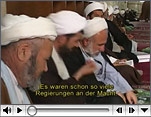|
|
 
Trailer
mpg-file (4,8 MB) |
|

Purchase DVD


Director: Jakob Preuss
Camera: Felix Korfmann
Editing: Klara Mottlova
Music: Marc Klemens
Sound Mixing: Mike Koloska |
| |
|
Today, a third of Iran’s population are under 14 years old, and around 70% are under 30. The generation born after the Revolution is beginning to rebel against inflexible state structures, as the country oscillates between traditional Islam and Western values.
In the West, little is known about these winds of change. Since the Revolution, images of Iran in the Western media have been predominantly negative. Ayatollah Chomeinei, Revolutionary Guards, the Fatwah placed on Salman Rushdie, the siege of the Iranian Embassy in London, the Iran-Iraq War, a Russian-backed nuclear programme with ambiguous motives, the burning of American flags by angry crowds on the streets and the state-sponsored assassination of opposition figures in Berlin in 1992 (Mykonos) – these have all figured large in Western perceptions of Iran.
It is in this context that “Torn Iran – Young people’s worlds in the Islamic Republic” offers some surprising insights into a rather enigmatic country. While government-murals on street walls still proclaim “Down with USA”, youngsters are busy fighting for their right to skate in the streets of Tehran. Female students chat on the internet and exchange tips on how to shorten the sleeves of their uniform, and wear the headscarf fashionably, without attracting the attentions of the “Herosaths” (the ‘moral police’ who patrol public buildings). A young Iranian tells us how he plans to avoid military service. We accompany a young Mullah as he heads to the swimming pool after attending a bellicose sermon at Friday prayers. We visit the poor suburbs of South Tehran, and listen to a young actress as she discusses her travels in Europe with her friends: - “Where are the canals again?” – “In Rome, aren’t they?”
As well as spending time with the high society of Tehran, which lives an ostensibly Western lifestyle, we attend a family celebration in the courtyard of a much more modest home in the suburbs. We also follow the daily routine of two young ‘Talabes’ (religious scholars) in Qom, the religious capital Iran. We observe a society that appears less repressed than is commonly assumed in the West; a society in which philosophy, religion, social issues and literature are openly discussed. At the same time, limits to free expression can be discerned by listening to the young people, who seem used to making themselves understood without being too direct.
We also meet two second-generation Iranian exiles, from Switzerland and Germany. Returning to Iran to visit their respective families, they give us their impressions of their country of origin.
Our five-week visit to Iran in October/November 2002 was originally planned as a research trip. But having been lucky enough to get permission to film in the oldest religious school of Qom, and having been able to shoot a range of interesting material elsewhere, we decided to produce a documentary. The protagonists speak variously in Farsi, French, German and English, to which we have added subtitles.
The film dispenses with added commentary and instead allows the protagonists to speak for themselves. Therefore, rather than ready-made conclusions, we gain some authentic and revealing insights into the lives of young Iranians and how they perceive themselves.
The viewer is left with as many questions as answers, but will get a feeling of what it is to be a young person living in Iran. The film deliberately renounces any overtly political themes, there are no questions about the situation in the Middle East or religious fundamentalism. An excessive focus on political issues can often obscure people’s real concerns. Nonetheless, such issues cannot be ignored and this documentary does not seek to do so. The political dimension is never far beneath the surface.
The scenes shot with the two young religious scholars are of particular value, since permission to shoot inside the Hozes is very difficult to obtain. So although the film may consist of rather more low-key and less spectacular images than the scenes of chanting crowds, and burning flags, frequently shown on Western television, the film is highly relevant to a range of contemporary issues. The two young Talabes smile politely as they explain that the task of the clergy, and Iran, is to convert the rest of the world to Islam.
All of the protagonists appear open, and the film avoids simplistic moral judgements. When the young Mullah asserts that Western society is founded on injustice, and that those who realise this naturally convert to Islam, it is difficult not to feel a little sympathy - even if today’s young student might be tomorrow’s hard-line figure of the regime. Yet one can also empathise with Dorna, from a rather secular family, who complains about the dress codes and the separation of men and women in university buildings. So too with Zoreh, a young girl from South-Tehran, who struggles to persuade her father to allow her to apply for university.
It is the debut work of the two young German film-makers.
|
|
|

